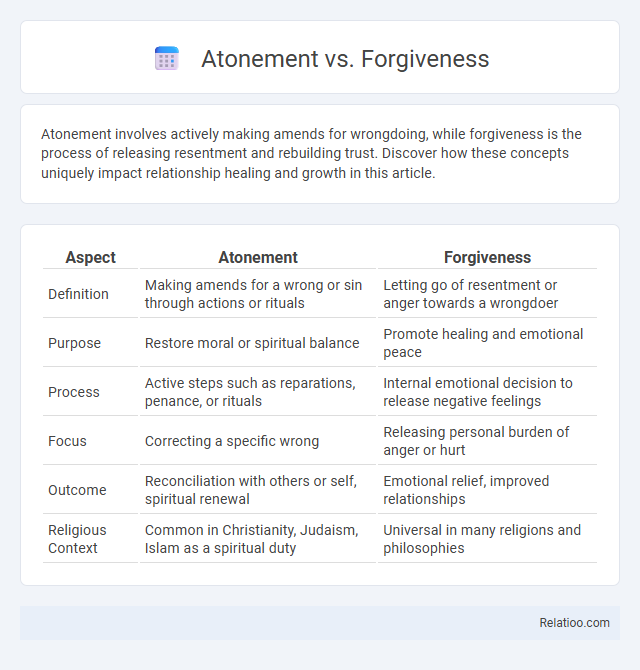Atonement involves actively making amends for wrongdoing, while forgiveness is the process of releasing resentment and rebuilding trust. Discover how these concepts uniquely impact relationship healing and growth in this article.
Table of Comparison
| Aspect | Atonement | Forgiveness |
|---|---|---|
| Definition | Making amends for a wrong or sin through actions or rituals | Letting go of resentment or anger towards a wrongdoer |
| Purpose | Restore moral or spiritual balance | Promote healing and emotional peace |
| Process | Active steps such as reparations, penance, or rituals | Internal emotional decision to release negative feelings |
| Focus | Correcting a specific wrong | Releasing personal burden of anger or hurt |
| Outcome | Reconciliation with others or self, spiritual renewal | Emotional relief, improved relationships |
| Religious Context | Common in Christianity, Judaism, Islam as a spiritual duty | Universal in many religions and philosophies |
Understanding Atonement and Forgiveness: Key Definitions
Atonement involves making amends or reparations for a wrongdoing, often through actions that seek to restore balance or heal relationships, while forgiveness is the conscious decision to release resentment and grant pardon to the offender without necessarily involving restitution. Understanding the distinction between atonement as an active process of addressing guilt and forgiveness as a personal choice to let go of negative feelings is crucial for emotional healing and reconciliation. The interplay between these concepts shapes how individuals and cultures approach justice, mercy, and healing after harm.
The Historical Roots of Atonement and Forgiveness
The historical roots of atonement trace back to ancient religious rituals where sacrifices symbolized reconciliation between humans and deities, primarily in Judaism and Christianity. Forgiveness, however, emerged as a moral and spiritual concept emphasizing personal release of resentment, deeply embedded in various cultural and religious traditions including Buddhism and Islam. While atonement often involves reparative actions or rituals to restore balance, forgiveness centers on internal emotional healing and the dissolution of grievances.
Psychological Perspectives: Healing Through Atonement and Forgiveness
Psychological perspectives emphasize that atonement involves actively making amends and taking responsibility for wrongdoings, facilitating healing by fostering self-awareness and moral growth. Forgiveness primarily supports emotional release, reducing resentment and promoting mental well-being by allowing individuals to let go of negative emotions tied to grievances. Healing occurs when both atonement and forgiveness integrate, enabling reconciliation and psychological restoration through accountability and compassion.
Religious Approaches: Atonement vs Forgiveness Across Faiths
Religious approaches to atonement and forgiveness vary significantly across faiths, with atonement often encompassing rituals, sacrifices, or penance to restore one's relationship with the divine, as seen in Christianity's emphasis on Jesus' sacrificial atonement and Judaism's Yom Kippur practices. Forgiveness typically involves a personal or divine act of pardoning sin or wrongdoings, prominent in Islam through Allah's infinite mercy and the concept of repentance (Tawbah). These overlapping yet distinct concepts reflect faith-specific theological frameworks where atonement addresses reconciliation with God, while forgiveness emphasizes divine or interpersonal pardon.
The Role of Guilt and Remorse in Atonement
Guilt and remorse play a crucial role in atonement, serving as internal catalysts that drive individuals to acknowledge their wrongdoings and seek reconciliation. Unlike forgiveness, which is granted by another party, atonement requires active personal responsibility and genuine emotional engagement with one's misdeeds. Your sincere feelings of guilt and remorse lay the foundation for meaningful atonement, fostering healing and restoring moral balance.
The Power of Forgiveness: Letting Go vs Holding On
The power of forgiveness lies in releasing resentment, which frees your mind and fosters emotional healing, whereas holding on to grudges entrenches pain and blocks personal growth. Atonement involves actively making amends for wrongdoings, complementing forgiveness by restoring trust and repairing relationships. Understanding these distinctions empowers you to navigate emotional challenges and cultivate inner peace effectively.
Atonement as Action: Steps Towards Making Amends
Atonement as an action involves a deliberate process of recognizing wrongdoing, expressing sincere remorse, and taking concrete steps to repair the harm caused. This process often includes restitution, seeking forgiveness from those affected, and making behavioral changes to prevent recurrence. Unlike forgiveness, which is granted by the harmed party, atonement is an active commitment by the wrongdoer to reconcile and rebuild trust through meaningful actions.
Forgiveness Without Atonement: Is It Possible?
Forgiveness without atonement challenges the traditional belief that genuine reconciliation requires acknowledgment of wrongdoing and reparative actions. Psychological studies reveal that while You can choose to forgive and experience emotional relief independently, true healing and restoration of trust often demand atonement from the offender. Understanding the nuanced roles of forgiveness, atonement, and repentance is essential for fostering authentic forgiveness and long-term relational harmony.
Societal Impacts: Community Healing Through Atonement and Forgiveness
Community healing relies heavily on the concepts of atonement and forgiveness, which together foster reconciliation and social cohesion. Atonement involves acknowledging wrongdoing and making reparations, promoting accountability and trust within the community. Forgiveness facilitates emotional release and restoration of relationships, enabling societies to move forward from conflict and trauma effectively.
Choosing the Path: When to Seek Atonement, When to Offer Forgiveness
Choosing the path between atonement and forgiveness hinges on the nature of the wrongdoing and the relationship involved. Seek atonement when personal responsibility and corrective actions are necessary to heal and restore trust, particularly in cases of tangible harm. Offer forgiveness when extending compassion can dissolve resentment and promote emotional healing, even without requiring repayment or reconciliation.

Infographic: Atonement vs Forgiveness
 relatioo.com
relatioo.com